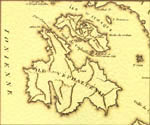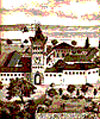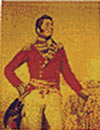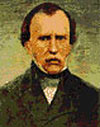Local History
Local Historical Background
 The island of Kefalonia has been inhabited since Palaeolithic times. In Roman times, the port of Fiscardo played an important part in the transport and exchange of materials and culture between the Italian peninsula and Greece. For a long time archaeologists believed the place referred to as Panormos in ancient times is today’s Fiscardo, but lacked proof of this. Then, in 2005, construction workers excavating for Fiscardo’s first shopping centre, discovered a plaque on which was inscribed the thanks of the people of Athens to the people of Panormos for allowing them to hunt there. This discovery ended all doubt that Panormos and Fiscardo are one and the same. In late 2006, two more important archaeological discoveries were made while excavations were taking place for a new hotel. One was of a grand tomb and the other of an ancient theatre. Work is now underway to date the discoveries.
The island of Kefalonia has been inhabited since Palaeolithic times. In Roman times, the port of Fiscardo played an important part in the transport and exchange of materials and culture between the Italian peninsula and Greece. For a long time archaeologists believed the place referred to as Panormos in ancient times is today’s Fiscardo, but lacked proof of this. Then, in 2005, construction workers excavating for Fiscardo’s first shopping centre, discovered a plaque on which was inscribed the thanks of the people of Athens to the people of Panormos for allowing them to hunt there. This discovery ended all doubt that Panormos and Fiscardo are one and the same. In late 2006, two more important archaeological discoveries were made while excavations were taking place for a new hotel. One was of a grand tomb and the other of an ancient theatre. Work is now underway to date the discoveries.
In the 12th century Kefalonia became the centre of marine enterprise between the Byzantines and the Normans. It also became a target of Norman raids, the most significant being that of 1084, led by Robert Guiscard who died the following year in the port of Panormos which was named Fiscardo from them on. Because of the great danger from pirates, the settlement only developed in the late 18th century and acquired its current look the following century particularly after the union of Eptanisa (the Ionian Islands) with the mainland Greece (1864). There are many variants of the Fiscardo name – Fiskardo, Fiskardon and Fiscardon are all used and acceptable.
History of Kefalonia Island
According to mythology, the island of Kefalonia was named after the mythical persona of Kefalos who was a mixture of two different mythical people. He was the son of Dion and Diomeda and Mercury, or the son of Pandion and Kreoussa, or Ersi. The goddess Jo loved king Kefalos and, in order to make him hers, she made him doubt the loyalty and devotion of his wife, Prokris. Jo encouraged him to appear before his wife wearing a disguise, and to seduce her with gifts. Prokris gave in to Kefalos and when she realized who he really was, she left, crying desperately. After Prokris wandered around Crete, she returned to Athens where the goddess Diana agreed to help her win back her husband. Unfortunately, while hunting, Kefalos saw the movement of Prokris behind the trees and, mistaking her for prey, he aimed at her and killed her. Desperate from his misfortune, Kefalos left Athens. He met Amphetryon and helped him defeat the Televoes and the Tafious. In return, Amphetryon offered Kefalos the island, which he called “Kefalonia”. According to another legend, the island was named after Kefalines of Kefalanes, a nation in western Greece. An increasing number of researchers believe that the Kefalines were Odysseus’s people and that the fabled kingdom of Odysseus was on Kefalonia and not on Ithaca as is popularly believed.
Pre-Historic-Period
 Excavations indicate that the island of Kefalonia has been inhabited since 10,000 BC. The existence of Palaeolithic civilizations on the island is verified. Mycenaean tombs which were discovered during excavations indicate that uniquely among the Ionian islands, Kefalonia thrived around 1 600 BC – the Mycenaean period. This occurred, among other reasons, because of the enormous corn production on the island, as well as Kefalonia’s commercial contacts with Ithaki and the town of Nidri, in Lefkada. According to another tradition, the island of Kefalonia was introduced to the Mycenaean civilization by emigrants to the Southern Peloponnese, Western Greece and Attica. This is indicated by similar findings from these areas.
Excavations indicate that the island of Kefalonia has been inhabited since 10,000 BC. The existence of Palaeolithic civilizations on the island is verified. Mycenaean tombs which were discovered during excavations indicate that uniquely among the Ionian islands, Kefalonia thrived around 1 600 BC – the Mycenaean period. This occurred, among other reasons, because of the enormous corn production on the island, as well as Kefalonia’s commercial contacts with Ithaki and the town of Nidri, in Lefkada. According to another tradition, the island of Kefalonia was introduced to the Mycenaean civilization by emigrants to the Southern Peloponnese, Western Greece and Attica. This is indicated by similar findings from these areas.
Antiquity
 Herodotus is the first historian to refer to the island by the name of Kefalinia, while Thucydides called the island Tetrapoli (Four Cities), because of the towns of Pali, Sami, Kranea (alias Krani) and Proni, which thrived during the Mycenaean years. The most significant of the cities was Sami, on the north-eastern part of the island. Pali was situated on the western peninsula, in the location of Palaiokastro; Krani was situated by the lagoon of Koutavos where Argostoli stands today; and Proni was situated on the south eastern part of the island. The four cities were not related to each other and had separate coins and regimes. The inhabitants of the islands worshipped the Olympian Gods and performed sacrifices in the temples in order to please the gods. Hesiodus refers to the temple of Ainios Zeus on mount Aino, while the existence of a second temple of Zeus is also mentioned on the isle south of Kefalonia. Kefalonia participated in the Persian Wars, in the battle of Plataies (479 BC) and in the Peloponnesian War, supporting both Sparta and Athens, as every city supported its political preference. In 218 BC, king Philip from Macedonia attacked the island and attempted to occupy it, but Athens helped Kefalonia defeat him.
Herodotus is the first historian to refer to the island by the name of Kefalinia, while Thucydides called the island Tetrapoli (Four Cities), because of the towns of Pali, Sami, Kranea (alias Krani) and Proni, which thrived during the Mycenaean years. The most significant of the cities was Sami, on the north-eastern part of the island. Pali was situated on the western peninsula, in the location of Palaiokastro; Krani was situated by the lagoon of Koutavos where Argostoli stands today; and Proni was situated on the south eastern part of the island. The four cities were not related to each other and had separate coins and regimes. The inhabitants of the islands worshipped the Olympian Gods and performed sacrifices in the temples in order to please the gods. Hesiodus refers to the temple of Ainios Zeus on mount Aino, while the existence of a second temple of Zeus is also mentioned on the isle south of Kefalonia. Kefalonia participated in the Persian Wars, in the battle of Plataies (479 BC) and in the Peloponnesian War, supporting both Sparta and Athens, as every city supported its political preference. In 218 BC, king Philip from Macedonia attacked the island and attempted to occupy it, but Athens helped Kefalonia defeat him.
The Roman Years
 In 187 BC, the Romans occupied the island of Kefalonia. Despite the resistance of the locals, the Romans conquered the island and destroyed Sami. During the Roman Rule, the inhabitants of Kefalonia were constantly threatened with raids by pirates and conquerors who took away their fortunes, thus making life on the island impossible. In 50 BC, the island was ruled by Gaius Antonios. In the second christian century, Poplius Aelius Adrianus offered the island as a present to Athens, and the island, the area surrounding Sami in particular, progressed economically.
In 187 BC, the Romans occupied the island of Kefalonia. Despite the resistance of the locals, the Romans conquered the island and destroyed Sami. During the Roman Rule, the inhabitants of Kefalonia were constantly threatened with raids by pirates and conquerors who took away their fortunes, thus making life on the island impossible. In 50 BC, the island was ruled by Gaius Antonios. In the second christian century, Poplius Aelius Adrianus offered the island as a present to Athens, and the island, the area surrounding Sami in particular, progressed economically.
Byzantine Era
 During the Byzantine Era, Kefalonia was often raided by pirates. The island, along with 64 other provinces and 935 cities, belonged to the Byzantine emperor. In the 10th century AD, Constantinos Porfyrogenitos indicated that the island was part of the “Scheme of Kefalonia”, which was established by Leon VI, as surviving seals prove. The Byzantine Era ended in 1084, when the powerful Norman warlord Robert Guiscard failed in an attempt to occupy the island.
During the Byzantine Era, Kefalonia was often raided by pirates. The island, along with 64 other provinces and 935 cities, belonged to the Byzantine emperor. In the 10th century AD, Constantinos Porfyrogenitos indicated that the island was part of the “Scheme of Kefalonia”, which was established by Leon VI, as surviving seals prove. The Byzantine Era ended in 1084, when the powerful Norman warlord Robert Guiscard failed in an attempt to occupy the island.
The Frank Years
 In 1084, Robert Guiscard attempted to occupy the island of Kefalonia, but the local people successfully managed to fight him off. He then retired to the village of Fiskardo where he died, not before naming the village after himself. Subsequently the Norman noble Boimond took violent revenge against the locals who had dared to resist Guiscard. In 1103 and 1125, the Crusaders attacked the island. Kefalonia was briefly occupied by the Normans in 1147, but the Byzantine emperor Manuel, with the help of the Venetians, defeated them. Nine years later, Manuel signed a peace treaty with the Normans in terms of which the Ionian islands, including Kefalonia became Norman territory. In 1185, the Sicilian King Gullielmo gave Kefalonia to Admiral Margaritoni, as part of the “Palatian Country of Kefalonia and Zakynthos”. In 1194 Margaritoni was succeeded by the pirate Matteo Orsini, who constantly raided the surrounding areas. The Orsini family with the help of a multitude of rogues and murders ruled the island for 150 years, when, in 1357, they were succeeded by the Tokos dynasty. Kefalonia was ruled by this dynasty until 1479, when Turks conquered the island.
In 1084, Robert Guiscard attempted to occupy the island of Kefalonia, but the local people successfully managed to fight him off. He then retired to the village of Fiskardo where he died, not before naming the village after himself. Subsequently the Norman noble Boimond took violent revenge against the locals who had dared to resist Guiscard. In 1103 and 1125, the Crusaders attacked the island. Kefalonia was briefly occupied by the Normans in 1147, but the Byzantine emperor Manuel, with the help of the Venetians, defeated them. Nine years later, Manuel signed a peace treaty with the Normans in terms of which the Ionian islands, including Kefalonia became Norman territory. In 1185, the Sicilian King Gullielmo gave Kefalonia to Admiral Margaritoni, as part of the “Palatian Country of Kefalonia and Zakynthos”. In 1194 Margaritoni was succeeded by the pirate Matteo Orsini, who constantly raided the surrounding areas. The Orsini family with the help of a multitude of rogues and murders ruled the island for 150 years, when, in 1357, they were succeeded by the Tokos dynasty. Kefalonia was ruled by this dynasty until 1479, when Turks conquered the island.
Venetian Rule
 In 1500, the Venetians and the Spanish, violating the treaty acknowledging Turkish dominion over Kefalonia, attacked and conquered the island. Venetian Rule lasted 300 years with the help of local nobles. The nobility were granted a number of privileges but the common people lived in poverty. In 1538, the Turkis pirate Hairedin Barbarossa attacked Kefalonia, causing severe damage and enslaving 13,000 people. In spite of this setback, the island attracted numerous settlers from the mainland entrenching the Greek character of the island. During the last years of the Venetian Rule, there were severe disputes between the rich families of the island which led to bitter vendettas. Venetian Rule ended in 1797, when the French occupied the island.
In 1500, the Venetians and the Spanish, violating the treaty acknowledging Turkish dominion over Kefalonia, attacked and conquered the island. Venetian Rule lasted 300 years with the help of local nobles. The nobility were granted a number of privileges but the common people lived in poverty. In 1538, the Turkis pirate Hairedin Barbarossa attacked Kefalonia, causing severe damage and enslaving 13,000 people. In spite of this setback, the island attracted numerous settlers from the mainland entrenching the Greek character of the island. During the last years of the Venetian Rule, there were severe disputes between the rich families of the island which led to bitter vendettas. Venetian Rule ended in 1797, when the French occupied the island.
French-Russian Rule
 On 28 June 1797, the French occupied Kefalonia. Napoleon promised liberation for the Ionian Islands. The book listing the names and the privileges of the nobles, “Libro d’oro”, was burnt in Argostoli’s square amid much celebration by the local people. French rule of the Ionian Islands became official with the Treaty of Kamboformio on 17 October 1797. The Ionian Islands became part of the French State on 1 November 1797. The following year, the allied fleet of Russians, Turks and English defeated the French at Aboukir and their fleet disembarked at Argostoli, where a government was appointed, its president being K. Horafas.
On 28 June 1797, the French occupied Kefalonia. Napoleon promised liberation for the Ionian Islands. The book listing the names and the privileges of the nobles, “Libro d’oro”, was burnt in Argostoli’s square amid much celebration by the local people. French rule of the Ionian Islands became official with the Treaty of Kamboformio on 17 October 1797. The Ionian Islands became part of the French State on 1 November 1797. The following year, the allied fleet of Russians, Turks and English defeated the French at Aboukir and their fleet disembarked at Argostoli, where a government was appointed, its president being K. Horafas.
On 21 March 1800, in Constantinople, the “Ionian State” was founded under the Sultan’s supervision. In return for their support the rich nobles of Kefalonia were granted exclusive privileges for ruling. This caused widespread resentment and led to insurrections on all the Ionian Islands which were violently suppressed by the conquerors. In 1802, by popular demand, elections took place in Kefalonia and on 23 December 1803 the democratically elected representatives were charged with the creation of a new constitution which would later establish the “Democracy of the Ionian Islands”. In 1807, the Ionian Islands came under the French rule again with Field Marshal Berthieux in command. After several changes, the “Democracy of the Ionian Islands” was maintained and people hoped for a peaceful life. Unfortunately, their hope did not last for long, as the English occupied Zakynthos, on 19 September 1809.
English Occupation
 On 19 September 1809, the English occupied Zakynthos and later, in spite of French objections, all the Ionian Islands, came under English occupation. With the treaty of Paris, the “United States of the Ionian Islands” was formed. According to this treaty, the Ionian Islands were to be under the command of the English Lord Commissioner. During the English Occupation, Kefalonia developed considerably in terms of roads and it was in this period that the bridge of Drapano which joins Argostoli with the Lagoon of Koutavos was constructed.
On 19 September 1809, the English occupied Zakynthos and later, in spite of French objections, all the Ionian Islands, came under English occupation. With the treaty of Paris, the “United States of the Ionian Islands” was formed. According to this treaty, the Ionian Islands were to be under the command of the English Lord Commissioner. During the English Occupation, Kefalonia developed considerably in terms of roads and it was in this period that the bridge of Drapano which joins Argostoli with the Lagoon of Koutavos was constructed.
Yet another constitution this one the Constitution of 28 December 1817 imposed a series of unpopular measures and led to a series of insurrections.
The Revolution of 1821 – English Occupation – Union
 Although Kefalonia remained under English rule, the islanders actively participated in the Greek revolution against Turkish rule. Constantinos and Andreas Metaxas, Gerasimos and Dionissios Fokas, Demetrios Hoidas, Gerasimos Orfanos and Loukas Valsamakis were some of the freedom fighters from Kefalonia. The most significant event in which Kefalonia participated was the battle of Lalas, in Helia. There, with the help of the Peloponnesian army, Andreas and Constantinos Metaxas defeated the Turks who invaded the village on 24 June 1821. At that time, the Ionian Commissioner was Charles Napier, a democrat who supervised significant construction in Kefalonia, one of them being the building Markato in Lixouri, which initially housed the island’s Court.
Although Kefalonia remained under English rule, the islanders actively participated in the Greek revolution against Turkish rule. Constantinos and Andreas Metaxas, Gerasimos and Dionissios Fokas, Demetrios Hoidas, Gerasimos Orfanos and Loukas Valsamakis were some of the freedom fighters from Kefalonia. The most significant event in which Kefalonia participated was the battle of Lalas, in Helia. There, with the help of the Peloponnesian army, Andreas and Constantinos Metaxas defeated the Turks who invaded the village on 24 June 1821. At that time, the Ionian Commissioner was Charles Napier, a democrat who supervised significant construction in Kefalonia, one of them being the building Markato in Lixouri, which initially housed the island’s Court.
On 14 September 1848, in the light of popular demand, Ionian Commissioner Seaton granted the people significant privileges. The next Commissioner, George Eward, wanted to change the Constitution but was prevented from doing so the Conservatives. A new series of insurrections forced Queen Victoria to proclaim elections in 1850, after which the first Parliament was established. The Parliament’s duration was short, as it dissolved after the union of the Ionian Islands with the rest of Greece. The crisis of the English policy regarding Greece and the peoples insurrections forced England to secede from the dominion of the Ionian Islands and on 23 September 1863, the Parliament voted in favour of union with the rest of Greece. On 21 May 1864, Thrasivoulos Zaimis officially received the Ionian Islands from Henry Storcks.
Modern Years
 During World War II, Kefalonia was occupied by the Italians in 1941. In September 1943, the Italians changed sides and many soldiers elected to fight the German army then stationed on the island. The Italians were defeated and thousands of Italian soldiers executed. In all 9,500 Italian soldiers lost their lives. The people of Kefalonia were actively involved in the Greek Resistance and fought for the country’s liberation throughout World War ll.
During World War II, Kefalonia was occupied by the Italians in 1941. In September 1943, the Italians changed sides and many soldiers elected to fight the German army then stationed on the island. The Italians were defeated and thousands of Italian soldiers executed. In all 9,500 Italian soldiers lost their lives. The people of Kefalonia were actively involved in the Greek Resistance and fought for the country’s liberation throughout World War ll.
In 1953, a massive earthquake caused severe damage to Kefalonia. The majority of the houses in Argostoli collapsed and led to large scale emigration. Kefalonia entered a period of economic hardship which only the relatively recent influx of tourists has ended.
